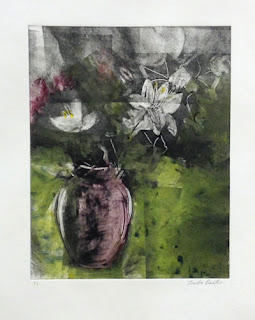I live on Eastern Long Island, surrounded by water. The beaches on the Atlantic Ocean and the Long Island Sound are among the most beautiful on the planet! I've been beachcombing and collecting shells my entire life, so naturally I use the shells for still life. The following drawings are lifesize. I enjoy arranging shells in different combinations, making formal compositions within a rectangle. Each shell is carefully placed to make the most of the negative space on the page, and to show the shape in its most characteristic view.
 |
| "Five Shells," graphite on watercolor paper, 6" x 9" |
The tools to make these detailed drawings are simple: number 2B and 4B drawing pencils, kneaded eraser, white plastic eraser, single-edged razor blade (to sharpen the white eraser and pencils) tortillon for smudging, sandpaper pad to keep the pencil and tortillon sharp, strong natural sunlight, and smooth 100% rag watercolor paper.
 |
"Four Shells," graphite on watercolor paper, 6" x 9"
|
You will notice that I don't try to pick out perfect shells. Some of these shells are broken, have drill holes, bleached and worn by the sun and salt water, and are deteriorated almost beyond recognition. Shells on a beach can be 100 years old! Or they can be fresh that week. Common shells on Long Island beaches included in these drawings: hard clam (quahog), ribbed mussel, scallop, cockle, moon snail shell, and slipper snail shells. The slipper shells come from the north shore beaches, and from Orient Point.










































